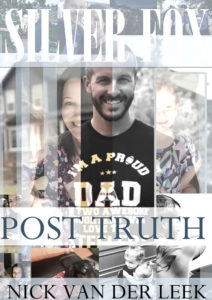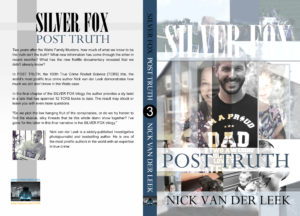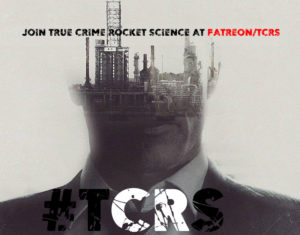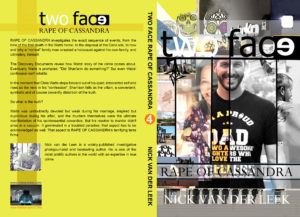Many of Malcolm Gladwell’s techniques are highly applicable to true crime. Thin-slicing is one. An example of just how brilliantly effective thin-slicing can be is in the hugely complex quagmire of serious relationships and marriage. How the heck does one thin-slice that? And yet, we can.

When couples show one particular trait the relationship is predictably doomed. That trait is Contempt.
This is a fascinating insight into perhaps the most complex of all human and social dynamics – romantic relationships. How often have we all been stung, misled, betrayed and lied to? How often have others felt that way way – and often misunderstood – those traits in us? When couples first engage, whether on Tinder or at the altar, what everyone wants to know including them is: is this fucker going to last?
Contempt provides the litmus test. If there’s any contempt in the beginning, a relationship is not likely to see a very good, very happy or very long run. Contempt cuts through the crap of what the Terminator once referred to as “the dynamics of human pair bonding”.
Is a marriage going to end in divorce? If there’s contempt in the beginning, middle or end, it surely will.
Now, we can apply the same Gladwellian techniques almost across the board with true crime. These are just a few examples of thin-slicing tricks that work more often than not in true crime:
- The absence of evidence is also evidence. I’ve heard prosecutors in court phrasing it slightly differently – the absence of evidence isn’t evidence of absence. What this means is where there is no evidence, where we would expect to see it [regardless of whether there is a crime or not] this in itself is evidence of something. A good example is deleted cell phone data, or a crime scene that has recently been vacuumed, or laundry done in the middle of a murder etc.
- Not all liars are murderers, but all murderers are liars. Just as contempt is a quick route to check whether a relationship will stand the test of time or not, if a suspect – or potential suspect – proves to be even a little economical with the truth especially during an interrogation, this tends to be a red flag. There are exceptions, Nichol Kessinger being a current example. But in true crime it’s usually not hard to find out whether someone is telling the truth or not. Invariably it’s not a little white lie here or there, it’s a case of living a lie.
- Social death of the perpetrator as a precursor to murder. This is more difficult to recognize, and thus tougher to thin-slice, because it’s symbolic, and this is really the area we miss when trying to figure out other people. What matters to us matters to others in different proportions.

- The Temptation of PleasureLand. Whether it’s Oscar Pistorius or Amanda Knox, OJ or Chris Watts, what crimes invariably involve is a PleasureLand calling from a distance. The crime is intended to make sure access is not denied to an imagined PleasureLand. PleasureLand both tempts the perpetrator, and numbs their sense of reality.
Once one gets the hang of Gladwellian thin-slicing, it feels like everything can be thin-sliced.
There’s a lot of thin-slicing going on in true crime, especially in the media coverage. It’s inevitable that talk show hosts will try to reduce high-profile crimes that have been bumper-to-bumper for weeks, months, sometimes years, to a golden nugget. Do they get it right?
True crime is a complex psychology, and tends to have very complex gears and machinery driving antisocial behavior. The identifies of people are complex, the dynamics between them even more so. And since so much of this machinery is deliberately hidden, while some of it is freely disclosed, this challenges and tests our ability to discern truth from reality. Most of us can’t, and no one can without doing their due diligence, spending time getting to know the people involved.
Just as identity isn’t the same as character, truth isn’t the same as reality. While identity is constant, character can be refashioned, rebooted, reimagined. Truth isn’t interchangeable with this or that reality. Reality is whatever we believe, or say it is. Truth, the TRUE in True Crime Rocket Science isn’t a matter of beliefs, it’s scientific.
In true crime, typically when an expert says it that’s the new reality. When an influential person prognosticates that becomes true crime gospel. But that’s not truth. That’s thin-sliced reality. Thin-sliced truth is harder and far more difficult to do properly, especially in true crime. It takes a mind practiced in criminal psychology, and saturated with knowledge of the case, to come close to getting it right.
We see it when Dr. Phil thin-slices Chris Watts’ Sermon on the Porch, and assesses him as guilty because he’s a narcissist. And then the true crime forums are flooded with people repeating that word.
When an ex-FBI profiler on Dr. Phil calls Watts a psychopath, the true crime world shudders with new revelation. That’s why this crime was committed!
When an ex-FBI profiler, the legendary John Douglas [AKA Mindhunter] says he thinks Amanda Knox is innocent, that’s enough – apparently – for Gladwell.

Douglas was paid handsomely for his expert opinion in the West Memphis 3 case, basically applying the same thin-slicing to Damien Echols as Amanda Knox. It goes like this: “Just because you behave in a weird way after a vicious murder [in Echols’ case the triple murder of three eight-year-old boys], doesn’t mean you were involved in a crime.”
Douglas was also called by John Ramsey’s defense lawyers within two weeks of JonBenet’s murder. Douglas famously bragged that after two hours of talking to John Ramsey [who appeared “appropriately sad and depressed”], Douglas told Ramsey’s lawyer Bryan Morgan – of Haddon, Morgan and Foreman – “I believe him.”
A Grand Jury two years later did not, and the results of that hearing were kept secret for the next 13 years. And then? The public thin-sliced the then District Attorney’s statement that “there’s not enough evidence to have a trial” to mean that’s what the Grand Jury thought. It wasn’t.
Thin-slicing can be used just as easily to manipulate. In Amanda Knox’s case, if you were trying to influence public opinion [after her original conviction], where would be the obvious place to start? Start by undermining the Italian justice system. That’s what they did and it worked.
But let’s look a little closer at the way Gladwell thin-slices the Knox saga, and why Knox got her way in the end.

From the New York Times:
In “Talking to Strangers” he asks why we are “so bad” at understanding people we haven’t met before. We often can’t tell when a stranger is lying to us (“Puzzle Number One”), and meeting a stranger face-to-face doesn’t necessarily help our understanding of who they are (“Puzzle Number Two”).
Amanda Knox has always been an enigma. One might say the same of Damien Echols, Oscar Pistorius, Casey Anthony and Chris Watts. These men and women aren’t the average. Look closer, and at the time they were accused of murder, they were both on the fringes of society and trying to break into PleasureLand.

In true crime, thin-slicing can be a double-edged sword. Just as weird behavior can be used to say someone isn’t necessarily guilty of something, weird behavior can be used to say someone is. When Douglas met John Ramsey and Ramsey appeared appropriately sad, there was nothing weird about that. When Knox was photographed outside the villa where Meredith lay dead, having been brutally attacked and bled to death [she drowned in her own blood], Knox was kissing her boyfriend. This strange behavior persisted at the police station, where everyone else was grief-stricken and shocked, while Knox continued to flirt and giggle with her Italian lover. And Knox seemed to play the goofy excuse in court, as a ploy to explain her strange behavior at the scene.
When Knox appeared in Italy most recently, she’d learned to portray a different look:

Obviously, Gladwell and Douglas are too busy giving lecture tours on expert lie-spotting to spend any time on one particular case, or they would see the not so subtle way they, and many are being manipulated.
Knox was recently caught out trying to solicit funds for a wedding that had already taken place.
Whether we want to call that a lie or just sneakiness, it’s one of many instances, going all the way back to Knox framing her boss Patrick Lumumba when the walls moved it. It seemed like she knew a little too much then when she fingered a black man, her boss, when the suspect turned out to be a black dude who’d hung out with Knox and her pals at home.
The critical aspect Gladwell, Douglas and the Thin-Slicing crow have missed, is the most obvious. If someone is weird, just in their daily behavior. If they’re loud and attention-seeking, this and that, what are they like to live with? And how does that translate to Knox’s roommate getting murdered over a long holiday weekend when everyone in the villa had decamped to their families, except the expat American student and her expat British neighbor, right next door [who was trying to study].
The New York Times does it’s often version of thin-slicing. Firstly it thin-slices Gladwell’s book, then thin-slices his book’s version of the Knox case. It all comes down to 1) the overwhelming evidence that someone else was guilty and 2) Knox didn’t grieve when her friend died.

Overwhelming evidence pointing to another culprit.
If we apply the logic of the Knox case to the West Memphis 3 case [officially unsolved], then we could also say only one of the West Memphis 3 committed the murders, why should all three take the fall? It’s nonsense. In the Knox case there were originally three convictions: Ivorian Rudy Guede, who had smoked and sold marijuana on previous occasions with the girls in the house. Knox’s boyfriend, Raffaele Sollecito who it was said had been caught viewing bestiality porn and used cocaine, and Amanda Knox.
The Pro-Knox site has been explicit in trying to debunk the drug narrative as a myth.
Of course just as behaving in a weird way may be a sign that you’re just a weirdo, it may also be a sign of habitual drug use, with all the associated Pinocchio behavior and stringing others along, thrown in. Once again, if you’re two students sharing space in a far flung villa in Italy, and you’re not both equally caught up in Pinocchio goes to PleasureLand, why wouldn’t conflict ensure?
Knox was guilty because she didn’t act like the prototypically grieving friend
It wasn’t just that Knox didn’t act right at the crime scene, or at the police station. It wasn’t that someone else had to smash down Meredith’s bedroom door, even though Knox was at home. It wasn’t the half a dozen confessions Knox gave, each one contradicting the other. It wasn’t her boyfriend withdrawing his alibi.
It was after Meredith was dead, she expected life to continue as usual. She expected to stay in her room, and continue to go to classes. All of Meredith’s British friends left Perugia immediately after the murder. They suspended their studies and went home. They attended Meredith’s funeral. They gave their statements and almost all had alibis.
Knox wanted to stay in Italy. She told her parents as much. She told them she didn’t want to go home. Her friend had just been murdered in the room next door, and the murderer [at that stage] was still out there, and she wanted to continue with her life? That only makes sense if you thin-slice it one way.
Thin-slicing has its limits, but apparently, so do ex-FBI profiling legends.



Who do you despise the most in True Crime? Damien Echols is my pick [WARNING: GRAPHIC IMAGES]























Recent Comments